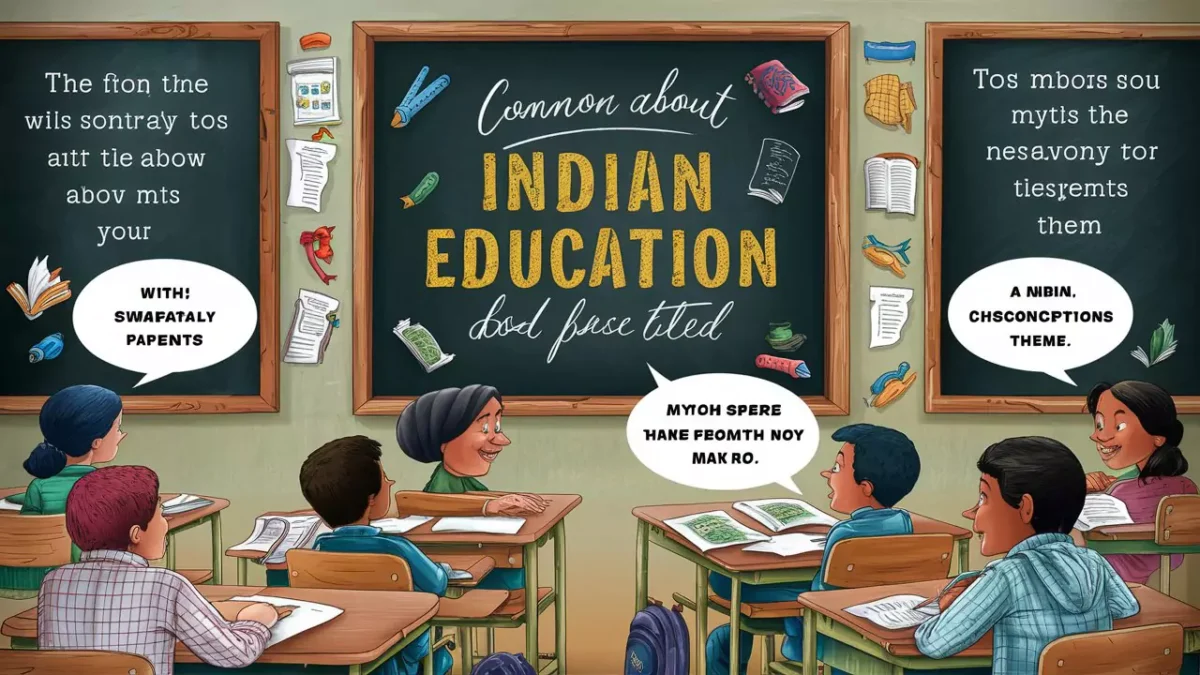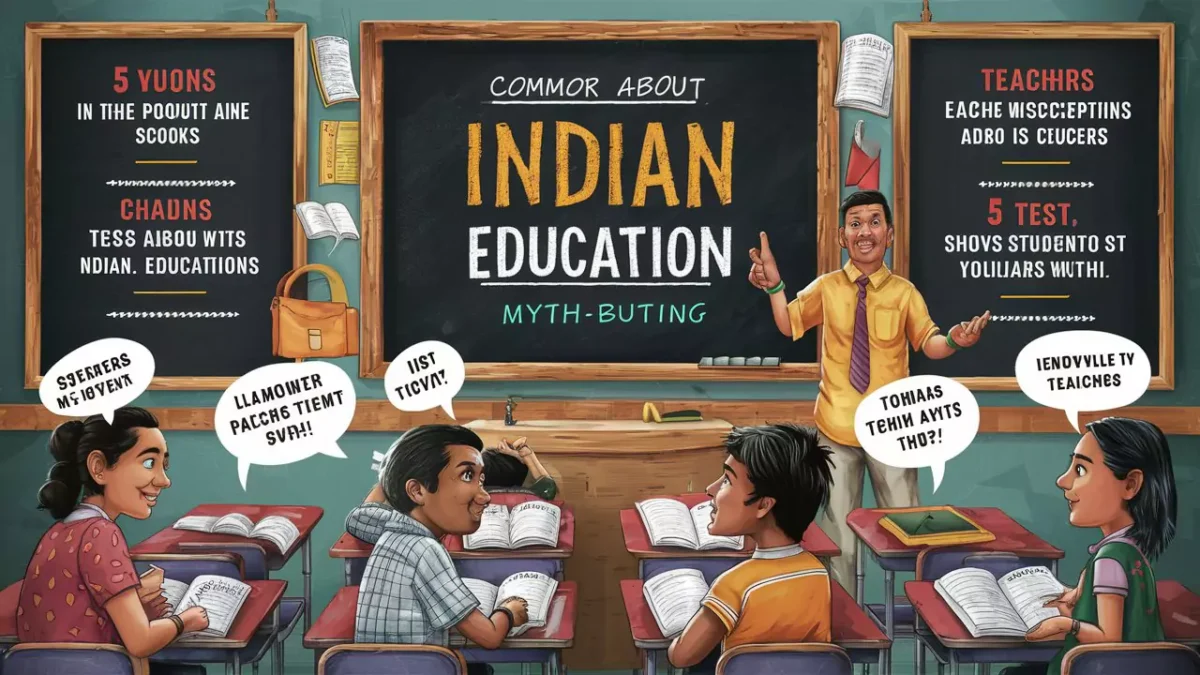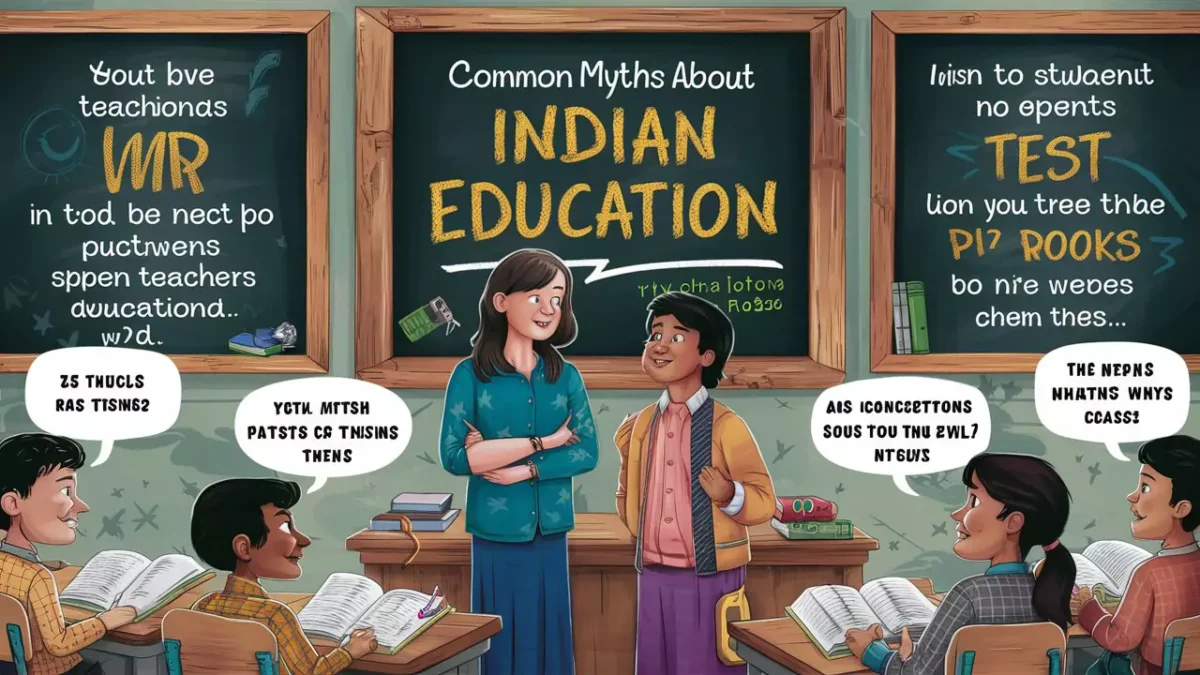Table of Contents
Toggle25 Common Myths About Indian Schools and Higher Education Debunked
The Indian education system has long been a topic of debate, scrutiny, and reform. Over time, myths about education in India have permeated public discourse, clouding the truth and complicating meaningful change. These misconceptions often overshadow the real issues plaguing the education system, stalling the much-needed progress toward a modern, efficient, and inclusive framework.
In this blog post, we will delve into the top myths in Indian education, debunk them with facts, and shed light on the truth about Indian education.
Debunking 25 major myths of Indian education
Myth 1: Indian Education System Focuses Only on Rote Learning
One of the most persistent Indian education myths is that it entirely revolves around rote learning. While rote memorization has been a hallmark of traditional Indian education in the past, this stereotype doesn’t reflect the ongoing transformation.
The Truth: Over the years, several education reforms have emphasized critical thinking, creativity, and practical learning. Initiatives like the National Education Policy (NEP) 2020 are designed to move beyond rote learning by integrating skill-based and interdisciplinary education. Many schools and universities now adopt experiential learning models and innovative teaching methods.
Myth 2: Indian Schools Only Produce Engineers and Doctors

A widespread misconception about Indian schools is that the system forces students into limited career paths, primarily engineering and medicine.
The Truth: While societal and familial expectations often steer students toward these professions, the education system itself provides a diverse range of opportunities. Today, fields like liberal arts, design, media, and entrepreneurship are gaining equal recognition. Moreover, government initiatives are encouraging vocational training and non-traditional career paths.
Myth 3: Higher Education in India is Globally Uncompetitive
This higher education myth in India paints a grim picture of the country’s universities, suggesting they fail to meet international standards.
The Truth: While it is true that not all Indian institutions rank highly on global scales, many universities, such as the Indian Institutes of Technology (IITs) and Indian Institutes of Management (IIMs), are globally acclaimed. These institutions consistently produce world-class professionals who contribute significantly to global industries. Moreover, reforms in the higher education system are aimed at boosting research and global collaboration.
Myth 4: The Indian Education System is Resistant to Change
Another common education myth in India is that the system is rigid and resistant to modern reforms.
The Truth: The education system has undergone substantial changes over the last few decades. The introduction of NEP 2020, digital learning platforms, and skill-development initiatives shows adaptability. The emphasis on integrating AI, coding, and digital literacy into school curriculums also reflects a forward-looking approach.
Myth 5: Private Schools Are Always Better Than Government Schools
Many parents believe that enrolling their children in private schools guarantees better education, perpetuating this false belief about Indian education.
The Truth: While some private schools offer excellent facilities, the notion that government schools are inherently inferior is misleading. Numerous government schools, particularly those supported by central initiatives like Kendriya Vidyalayas and Navodaya Vidyalayas, have demonstrated outstanding results. Efforts are underway to enhance infrastructure and teaching quality across public schools.
Myth 6: Traditional Indian Education Was Perfect
The glorification of ancient Gurukul systems often contributes to this traditional Indian education myth.
The Truth: While the Gurukul system had its strengths, it was far from perfect. It was limited to certain sections of society and excluded women and marginalized communities. Modern reforms aim to build an inclusive education system that ensures equal opportunities for all.
Myth 7: Indian Students Excel Only in STEM Fields
A stereotype often perpetuated globally is that Indian students are only proficient in science, technology, engineering, and mathematics (STEM).
The Truth: While Indian students have indeed excelled in STEM, their contributions in fields like literature, art, sports, and social sciences are equally commendable. Platforms like the International Booker Prize and global sporting events showcase the diverse talents of Indian youth.
Myth 8: Indian Schools Don’t Promote Creativity
A significant misconception about Indian schools is that they suppress creativity in favor of rigid academic frameworks.
The Truth: Many schools today integrate art, music, and theater into their curricula to foster creativity. Programs like Atal Tinkering Labs encourage innovation and out-of-the-box thinking among students. The shift toward holistic development is evident in both urban and rural schools.
Myth 9: Education in India is Affordable for All

This flaw in the Indian education system stems from the assumption that free education policies ensure accessibility for everyone.
The Truth: While government schools provide free or low-cost education, hidden costs such as uniforms, books, and private tuitions often make education unaffordable for marginalized communities. Addressing these barriers is crucial for creating an equitable education system.
Myth 10: Indian Education is Outdated and Irrelevant
Critics often claim that the Indian education system is outdated, failing to prepare students for modern challenges.
The Truth: While challenges remain, significant strides are being made to update the curriculum and align it with global standards. Digital education, industry collaboration, and the focus on soft skills and entrepreneurship are reshaping the system to meet contemporary needs.
Myth 11: Exams Are the Sole Measure of Success
A deeply entrenched belief in the Indian education system is that academic exams are the ultimate benchmark of a student’s success.
The Truth: Exams are only one part of the evaluation process. Today, many schools and universities emphasize extracurricular achievements, leadership skills, community involvement, and innovation alongside academic performance. The rise of alternative assessment methods, like portfolio-based evaluations and peer reviews, demonstrates this shift.
Myth 12: Students in Rural Areas Lack Talent
It is often assumed that students in rural India lack the potential to succeed academically or professionally, leading to stereotypes and biases.
The Truth: Rural students face systemic challenges, such as inadequate resources and poor infrastructure, but they are equally talented and capable. Initiatives like the Digital India campaign and organizations such as Pratham have highlighted success stories of rural students excelling in various fields, from technology to arts.
Myth 13: Online Learning is Not Effective in India
Many believe that online learning cannot work effectively in India due to digital divides and a preference for traditional teaching methods.
The Truth: While the digital divide is a valid concern, online learning platforms like Byju’s, Unacademy, and government initiatives like SWAYAM have made significant inroads. Hybrid learning models that combine online and offline approaches are gaining popularity, especially in higher education and skill development.
Myth 14: Indian Education Ignores Soft Skills
A frequent Indian education system misconception is that it focuses exclusively on technical skills and neglects interpersonal or soft skills.
The Truth: With global markets demanding well-rounded professionals, Indian schools and colleges are now prioritizing communication, teamwork, and emotional intelligence. Workshops, internships, and personality development programs have become integral to education.
Myth 15: The Education System in India is Too Theory-Oriented
Many believe that Indian education places excessive emphasis on theoretical knowledge while neglecting practical applications.
The Truth: This was once largely true, but times are changing. Vocational courses, internships, and partnerships with industries are helping students gain hands-on experience. The introduction of labs, maker spaces, and project-based learning in schools and colleges reflects this shift.
Myth 16: Indian Schools Lack Global Perspectives
Another myth about Indian schools is that they don’t equip students to think globally or understand international issues.
The Truth: Increasingly, Indian schools are adopting international curriculums like the IB (International Baccalaureate) and IGCSE, exposing students to global perspectives. Exchange programs and collaborations with international institutions further prepare students for global opportunities.
Myth 17: Students Who Fail Academics Are Failures in Life
A damaging stereotype perpetuates the idea that poor academic performance equals failure in life.
The Truth: Society is gradually acknowledging diverse talents and pathways to success. From entrepreneurship to creative arts, students are proving that academic grades are not the only determinant of future achievements. Many successful individuals, including prominent entrepreneurs and artists, have overcome academic struggles.
Myth 18: Only Urban Areas Can Foster Quality Education
It is often believed that only metropolitan cities can provide quality education, while smaller towns and villages are devoid of good schools and colleges.
The Truth: This is a misrepresentation. Numerous initiatives aim to decentralize education quality. Government-run programs like Navodaya Vidyalayas and NGOs like Teach for India are providing quality education to students in less privileged areas.
Myth 19: Scholarships Are Only for the Economically Weak
Many students and parents assume that scholarships are limited to those from economically disadvantaged backgrounds.
The Truth: Scholarships in India cater to a wide variety of needs, including academic excellence, sports achievements, specific talents, and even gender-based opportunities. Understanding the different types of scholarships can unlock financial aid for students from diverse backgrounds.
Myth 20: Indian Education Doesn’t Value Mental Health
Another major misconception about Indian schools is that they ignore the mental well-being of students.
The Truth: While mental health awareness in Indian schools was minimal in the past, it is now gaining importance. Schools and colleges are employing counselors, conducting mental health workshops, and integrating well-being programs into their schedules. However, much work remains to be done in this area.
Myth 21: Girls Receive Fewer Opportunities in Education
A long-standing misconception about Indian education is that girls are denied equal opportunities compared to boys.
The Truth: While gender disparity in education was historically a problem, there have been significant improvements. Programs like Beti Bachao, Beti Padhao and free education for girls in many states have bridged this gap considerably. Enrollment rates for girls in schools and higher education have risen sharply over the years.
Myth 22: Technology Will Completely Replace Teachers

With the increasing adoption of technology in education, some believe that teachers will become obsolete in Indian classrooms.
The Truth: Technology is a tool, not a replacement. The human touch in teaching, mentoring, and emotional support remains irreplaceable. Teachers play a critical role in guiding students and contextualizing content, making their presence vital even in tech-enabled classrooms.
Myth 23: Indian Education Doesn’t Encourage Sports and Extracurriculars
A widespread belief is that Indian schools overlook sports, arts, and extracurricular activities in favor of academics.
The Truth: Schools are increasingly recognizing the importance of extracurricular activities. Sports academies, art programs, and national-level competitions like Khelo India encourage holistic development. Many schools now include structured extracurricular schedules as part of their curriculum.
Myth 24: Indian Education is Corruption-Ridden
The notion that the Indian education system is riddled with corruption paints an overly negative picture.
The Truth: While challenges like bribery and nepotism exist in some areas, numerous institutions and initiatives are operating with transparency. Online admissions, digital fee payments, and regulatory reforms are minimizing corruption and promoting fairness.
Myth 25: Education Reforms Only Benefit Urban Elites
It is often assumed that reforms in the Indian education system cater only to urban or affluent communities.
The Truth: Policies like NEP 2020 aim to reach every corner of the country, including rural and underprivileged areas. By focusing on inclusive education and affordable resources, these reforms are designed to benefit all segments of society.
Real Issues in Indian Education
Debunking these myths allows us to focus on the real issues in Indian education, such as:
- Equity and Inclusion: Bridging the gap between urban and rural education.
- Teacher Training: Enhancing the quality of teaching through professional development.
- Infrastructure: Improving basic facilities like classrooms, libraries, and digital access.
- Assessment Methods: Moving toward holistic evaluation instead of exam-centric models.
Indian Education System Facts vs. Myths
It is essential to separate Indian education facts vs. myths to foster informed discussions about reforms. While myths hinder progress, acknowledging facts enables actionable solutions.
Breaking Indian Education Myths for a Better Future
The modern Indian education system is evolving, but overcoming deeply rooted misconceptions about Indian schools is crucial. By debunking education myths, we can pave the way for a robust, inclusive, and progressive education system.
What are your thoughts on the current state of Indian education? Share your views in the comments below!






